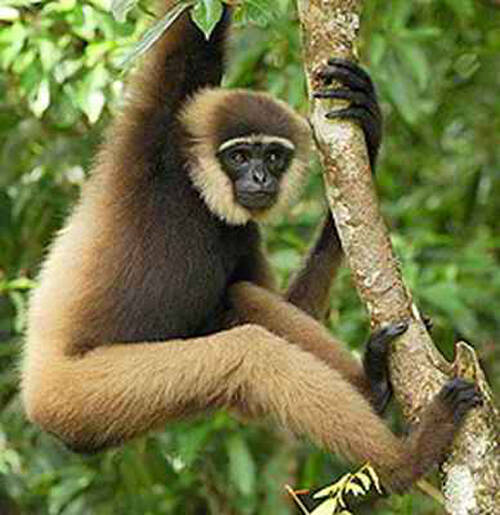Hylobates albibarbis
IUCN
LCBasic Information
Scientific classification
- name:Hylobates albibarbis
- Scientific Name:Hylobates albibarbis
- Outline:Primates
- Family:G.family genus
Vital signs
- length:50-76cm
- Weight:4-6kg
- lifetime:About 25 years
Feature
Short legs, hands longer than feet
Distribution and Habitat
Distribution: Indonesia (Kalimantan).
It is mainly found in tropical forests of Kalimantan, Indonesia. The species lives in primary and regenerated forests, most often tropical evergreen broadleaf forests, and peat swamp forest types. These arboreal primates have been recorded from forests, climbing to altitudes of up to 1,200 meters.
Appearance
The white-bearded gibbon was once a subspecies of the black-handed gibbon (Hylobates agilis albibarbis), but was identified as an independent species in 2001. It is a small ape species. The average weight of females is 5.4 kg, and that of males is 5.8 kg. The hair has a variety of different colors, including black, brown, camel and reddish brown. Both sexes have white eyebrows. Males have thick white bristles around their cheeks.
They have short legs, longer hands than feet, and long finger joints; they have a slender body, broad shoulders and narrow hips; they have long canine teeth. There are calluses on the hips, no tail and cheek pouches. There is a sound pouch in the throat, and they are good at singing.
Details
The white-bearded gibbon (scientific name: Hylobates albibarbis) was once a subspecies of the black-handed gibbon and was identified as an independent species in 2001.

White-bearded gibbons usually form a family of 4, including an adult male and an adult female, and the rest are semi-adult and young gibbons, with an adult male serving as the leader. Gibbons have a relatively long maturity period, and family relationships are not only stable, but also harmonious and friendly. Family members are generally very harmonious, caring for each other and defending each other.
The habits of the white-bearded gibbon are similar to those of the black gibbon. They live a family life with male and female spouses and are territorial. The territory of each group is about 54 hectares, but they only forage within 1.5 square kilometers in a day. During the day, they use their arms to climb branches and swing and jump on trees 20-30 meters high in the forest, using both their front and back limbs at high speed. Due to the high-altitude characteristics of this movement, they often change the direction of their chest and arms. Long-term evolutionary adaptation has made the sides of their shoulders flat, unlike monkeys, which are relatively wide. Their elbows are longer and can rotate 360 degrees in all directions. They can move forward and backward quickly, and their feet only play the role of assisting pedaling. They have keen hearing and smell, are timid, and afraid of cold.
The calls of white-bearded gibbons are the main form of communication among group members. Every morning, males and females sing in chorus, with ups and downs, sad and low, or intermittent sounds similar to blowing bubbles. The male's call is sandwiched between the female's call, and at the end of the call, a tail sound is added. Tactile communication is also important between parents and their offspring. Tactile communication involves grooming, mating, playing, and sometimes aggressive behavior. In addition to vocal and tactile communication, these animals also use facial expressions, gestures and body postures to communicate with their own species.
White-bearded gibbons consume a lot of fruit. Like other gibbons, these animals are mainly frugivores. They also eat a variety of other foods, including leaves, flowers and insects. Due to their high activity level, it is necessary to consume calorie-rich foods, and fruits have a high calorie content.
White-bearded gibbons reach sexual maturity at the age of 8, and there is no strict breeding season. The gestation period of females is about 7-8 months. After mating and conception, they still move with the group. After 3-4 months, their abdomens bulge slightly. As the fetus grows, their abdomens gradually increase in size, and their daily actions become more cautious, but they still stay with the group until giving birth. Birth usually occurs in autumn and early winter, and only one cub is born per litter. The newborn cub is light yellow in color and weighs 110-170 grams. It gradually turns black or brown-black after 4-5 months of age. They are weaned after 6 months and can live completely independently at 8 months, but they still do not leave the group until they are about 6 years old and close to sexual maturity. They slowly leave the group and live independently. They reach sexual maturity at the age of 7-8 and look for a mate. The lifespan is about 25 years. A couple can give birth to 5-6 babies in their lifetime, with an interval of about 40 months between each birth.
The white-bearded gibbon population has declined significantly due to fires in the 1990s and continued deforestation (including legal and illegal logging, drainage of peat swamps, and expansion of oil palm plantations). However, the downward trend in population is not confirmed by recent surveys. A large part of the species' range is in peat swamp areas - a highly threatened ecosystem. From 2003-2004, a total of 79 white-bearded gibbons were found to be traded in markets in Kalimantan. Hunting by humans and habitat degradation are the main reasons for the endangerment of the species.
The white-bearded gibbon is a species protected by national law throughout Indonesia. It lives in a number of protected areas, including Bukit Baka - Bukit Raya National Park, Ganung Palung National Park, and Tanjung Puting National Park.
Listed in the 2008 Red List of Endangered Species of the World Conservation Union (IUCN) ver 3.1 - Endangered (EN).
Listed in the CITES Appendix I of the Washington Convention as a protected animal.
Protect wild animals and eliminate game.
Maintaining ecological balance is everyone's responsibility!








